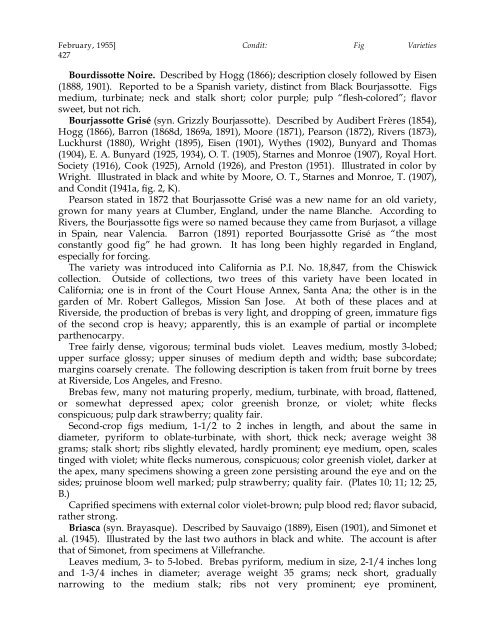Fig Varieties: A Monograph - uri=ucce.ucdavis
Fig Varieties: A Monograph - uri=ucce.ucdavis
Fig Varieties: A Monograph - uri=ucce.ucdavis
You also want an ePaper? Increase the reach of your titles
YUMPU automatically turns print PDFs into web optimized ePapers that Google loves.
February, 1955] Condit: <strong>Fig</strong> <strong>Varieties</strong><br />
427<br />
Bourdissotte Noire. Described by Hogg (1866); description closely followed by Eisen<br />
(1888, 1901). Reported to be a Spanish variety, distinct from Black Bourjassotte. <strong>Fig</strong>s<br />
medium, turbinate; neck and stalk short; color purple; pulp “flesh-colored”; flavor<br />
sweet, but not rich.<br />
Bourjassotte Grisé (syn. Grizzly Bourjassotte). Described by Audibert Frères (1854),<br />
Hogg (1866), Barron (1868d, 1869a, 1891), Moore (1871), Pearson (1872), Rivers (1873),<br />
Luckhurst (1880), Wright (1895), Eisen (1901), Wythes (1902), Bunyard and Thomas<br />
(1904), E. A. Bunyard (1925, 1934), O. T. (1905), Starnes and Monroe (1907), Royal Hort.<br />
Society (1916), Cook (1925), Arnold (1926), and Preston (1951). Illustrated in color by<br />
Wright. Illustrated in black and white by Moore, O. T., Starnes and Monroe, T. (1907),<br />
and Condit (1941a, fig. 2, K).<br />
Pearson stated in 1872 that Bourjassotte Grisé was a new name for an old variety,<br />
grown for many years at Clumber, England, under the name Blanche. According to<br />
Rivers, the Bourjassotte figs were so named because they came from Burjasot, a village<br />
in Spain, near Valencia. Barron (1891) reported Bourjassotte Grisé as “the most<br />
constantly good fig” he had grown. It has long been highly regarded in England,<br />
especially for forcing.<br />
The variety was introduced into California as P.I. No. 18,847, from the Chiswick<br />
collection. Outside of collections, two trees of this variety have been located in<br />
California; one is in front of the Court House Annex, Santa Ana; the other is in the<br />
garden of Mr. Robert Gallegos, Mission San Jose. At both of these places and at<br />
Riverside, the production of brebas is very light, and dropping of green, immature figs<br />
of the second crop is heavy; apparently, this is an example of partial or incomplete<br />
parthenocarpy.<br />
Tree fairly dense, vigorous; terminal buds violet. Leaves medium, mostly 3-lobed;<br />
upper surface glossy; upper sinuses of medium depth and width; base subcordate;<br />
margins coarsely crenate. The following description is taken from fruit borne by trees<br />
at Riverside, Los Angeles, and Fresno.<br />
Brebas few, many not maturing properly, medium, turbinate, with broad, flattened,<br />
or somewhat depressed apex; color greenish bronze, or violet; white flecks<br />
conspicuous; pulp dark strawberry; quality fair.<br />
Second-crop figs medium, 1-1/2 to 2 inches in length, and about the same in<br />
diameter, pyriform to oblate-turbinate, with short, thick neck; average weight 38<br />
grams; stalk short; ribs slightly elevated, hardly prominent; eye medium, open, scales<br />
tinged with violet; white flecks numerous, conspicuous; color greenish violet, darker at<br />
the apex, many specimens showing a green zone persisting around the eye and on the<br />
sides; pruinose bloom well marked; pulp strawberry; quality fair. (Plates 10; 11; 12; 25,<br />
B.)<br />
Caprified specimens with external color violet-brown; pulp blood red; flavor subacid,<br />
rather strong.<br />
Briasca (syn. Brayasque). Described by Sauvaigo (1889), Eisen (1901), and Simonet et<br />
al. (1945). Illustrated by the last two authors in black and white. The account is after<br />
that of Simonet, from specimens at Villefranche.<br />
Leaves medium, 3- to 5-lobed. Brebas pyriform, medium in size, 2-1/4 inches long<br />
and 1-3/4 inches in diameter; average weight 35 grams; neck short, gradually<br />
narrowing to the medium stalk; ribs not very prominent; eye prominent,
















![Fig Trees in North Carolina [Archive] - IDigMyGarden ... - Figs 4 Fun](https://img.yumpu.com/26905320/1/190x245/fig-trees-in-north-carolina-archive-idigmygarden-figs-4-fun.jpg?quality=85)